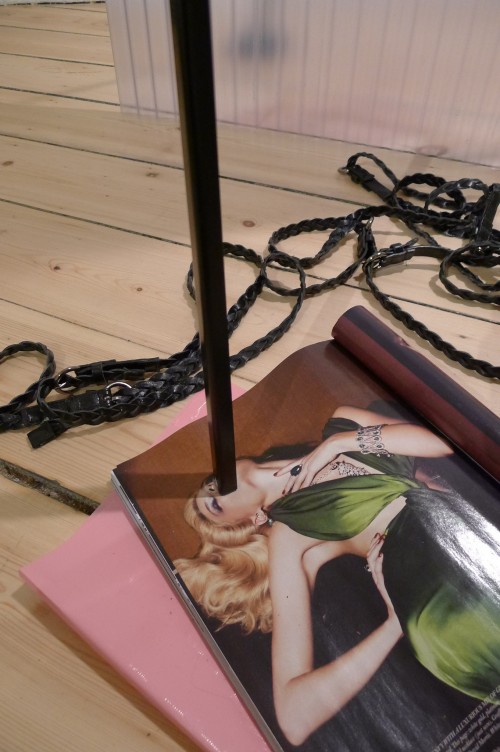
Samantha Donnelly’s sculptures bring together disparate materials to form delicate structures, which speak of accident, contradiction and transience at every turn. The everyday objects that intermingle in her work include building materials, beauty products, jewellery, stationery, household cleaning products, books and magazines, forming an eclectic and makeshift union. With a sense of rhythm that is built into the physical structure of works such as Contortionist, the materials seem to be engaged in a wild dance to a dissonant tune.
For the viewer-consumer there is a certain satisfaction to be derived from mentally ticking off the materials (one by one), but there are also the inevitable pitfalls when one fails to recognise a name of something – a name that may be absolutely alien and holds no meaning whatsoever. The viewer may want to scrutinize the work in all its details in order to identify the mysterious substance in question, but although every part of the sculpture seems familiar enough, one is still incapable of matching the name with the material with any certainty. The failure to recognise consumer-grade materials forces one to admit defeat in face of the vast universe of consumer products. If knowledge is power, this defeat on the minutest of scales highlights our impotence. We are forced to admit that we can never thoroughly know and understand the material world in which we live.
Donnelly, by employing a kitsch aesthetic that is often associated with glossy magazines, and features bold colours and clashing forms, creates structures that attract and repel the viewer simultaneously (such as a classical statuette strung with a chain of knotted rubber bands (in Illusions of Supersaturation). Looking at Circular Fictions and Absolute Truths, the viewer comes across various plinth-like blocks, on which printed paper, an open magazine, bright yellow fake nails and a bottle of spilled nail polish (green), among other things, are strewn. The viewer is forced into an ambivalent and awkward position in relation to the work. It provokes us to renounce what we are normally conditioned to consider as attractive and desirable. The work presents itself as an assault on our tastes and sensibilities.

I have spoken of her practice in relation to its sculptural dimension, in fact, references to classical and modernist sculpture are abundant in her work. The hardened clean wipes in Sharp Orbits Fall Flat #2 are reminiscent of the falling drapery in classical sculpture, especially since it had been a common practice in the past for sculptors to use starched fabric to study drapery. However, the geometric forms in her work also give some of the structures a constructivist feel. At the same time her work poses an unabashed challenge to the medium. In Outlining Venus, there is a massive hole in the grey foam board, presumably the shape of the goddess, and scraps of the broken foam board pile at the bottom of the vertical structure. In another work, Sharp Orbits Fall Flat #1, fragments of plaster, wood and other materials fill up the space between two painted wood beams. The inclusion of debris exposes the necessary and unsightly side-product created in the process of sculpture-making; this exposure defies the rule of sculpture and turns it inside out. On top of that, the use of bright, striking colours disturbs the focus on shape and form, and the coexistence of multifarious materials deflects from the traditionally mono-material and monochromatic sculpture.

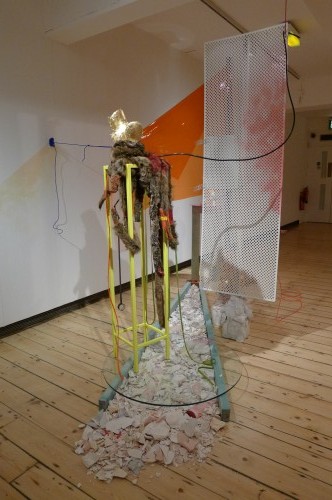
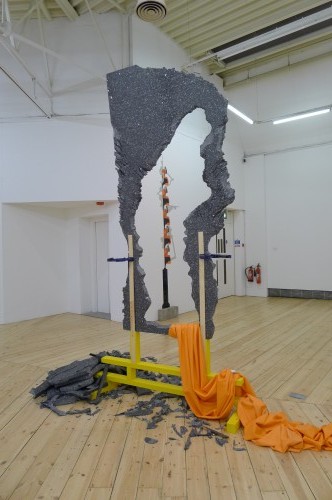
Most importantly, these structures defy the inherent logic of sculpture as a finite, self-contained entity. The parts are scattered and only come together to form a whole temporarily. They refuse to sit still and prefers to dance around, giving rise to a ‘sculpture’ that is constantly in a state of flux. The use of clamps and paper clips to hold the parts together highlights the temporality of the structures. Although some parts of the sculptures can be described as architectural, such as the corrugated plastic propped up like a wall by iron support in Illusions of Supersaturation, these are nonetheless impermanent structures like a stage set, that are going to be dissembled once the show is over. Precariousness is the rule, so much so that the work can be read as a parody of art forms that rely on the pretense of immortality to justify their existence and relevance.
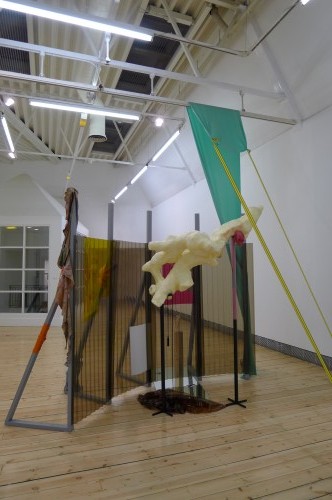
Using the strategy of cut and paste both literally, in the case of the magazine cutouts, and figuratively, ‘cutting’ things out of their contexts and ‘pasting’ them onto a three-dimensional space, Donnelly compellingly questions the stability and legitimacy of contemporary taste that os so deeply imbued with symbols of consumerism. She exposes the power of mass culture to control what we desire. Perhaps itwill inspire a newfound self-awareness in the viewer, that in turn will give rise to the possibility of resisting and subverting the aspirations that are packaged and forced upon us.



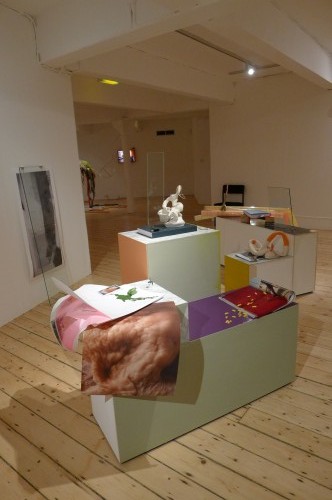
Leave a Reply